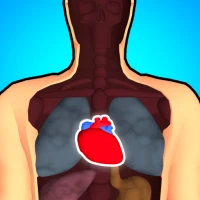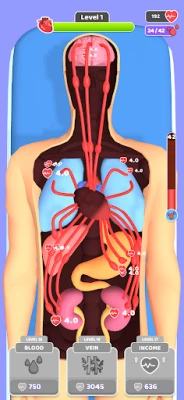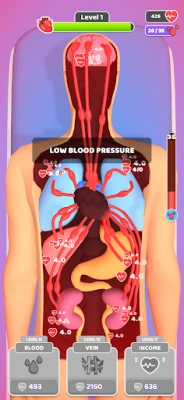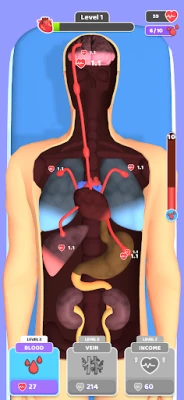
Latest Version
1.2.6
April 05, 2025
Supersonic Studios LTD
Games
Android
0
Free
com.MoodGames.ClickToLife
Report a Problem
More About Click to Life
Reviving Life: The Essential Role of Blood Circulation in Organ Function
Blood circulation is a vital process that sustains life by delivering oxygen and nutrients to organs and tissues throughout the body. Understanding how blood pumps through the veins and arteries is crucial for appreciating its role in maintaining health and vitality. This article delves into the intricacies of blood circulation, its significance, and how it connects to the overall functioning of the human body.
The Mechanics of Blood Circulation
At the heart of the circulatory system lies the heart, a muscular organ that acts as a pump to circulate blood. The heart consists of four chambers: the right atrium, right ventricle, left atrium, and left ventricle. Blood flows through these chambers in a coordinated manner, ensuring that oxygen-rich blood reaches the organs while returning oxygen-poor blood to the lungs for reoxygenation.
How Blood Pumps Through the Body
The journey of blood begins in the right atrium, where deoxygenated blood returns from the body via the superior and inferior vena cavae. From there, it moves into the right ventricle, which pumps it to the lungs through the pulmonary arteries. In the lungs, carbon dioxide is exchanged for oxygen, and the now oxygenated blood returns to the left atrium via the pulmonary veins.
Once in the left atrium, blood flows into the left ventricle, the strongest chamber of the heart. The left ventricle pumps oxygen-rich blood into the aorta, the largest artery in the body, which distributes it to various organs and tissues. This continuous cycle of pumping and circulating blood is essential for sustaining life.
The Importance of Blood Circulation for Organ Health
Every organ in the body relies on a steady supply of blood to function optimally. Blood circulation delivers essential nutrients, hormones, and oxygen while removing waste products like carbon dioxide and urea. Here’s how proper blood flow impacts specific organs:
The Brain
The brain requires a constant supply of oxygen and glucose to function effectively. Any disruption in blood flow can lead to serious consequences, including cognitive impairment or stroke. Maintaining healthy blood circulation is crucial for brain health and overall cognitive function.
The Heart
The heart itself is a muscle that needs a rich supply of oxygenated blood to function. Coronary arteries supply blood to the heart muscle, and any blockage can lead to conditions such as angina or heart attacks. Regular exercise and a healthy diet can promote better circulation and heart health.
The Lungs
The lungs play a critical role in oxygenating blood. Efficient blood circulation ensures that oxygen is delivered to the body while carbon dioxide is expelled. Conditions like chronic obstructive pulmonary disease (COPD) can impair this process, highlighting the importance of maintaining healthy blood flow to the lungs.
Factors Affecting Blood Circulation
Several factors can influence blood circulation, including lifestyle choices, medical conditions, and environmental factors. Understanding these can help individuals take proactive steps to enhance their circulatory health.
Lifestyle Choices
Regular physical activity is one of the most effective ways to improve blood circulation. Exercise strengthens the heart, improves vascular health, and promotes better blood flow. Additionally, a balanced diet rich in fruits, vegetables, whole grains, and lean proteins can support circulatory health by providing essential nutrients.
Medical Conditions
Conditions such as diabetes, hypertension, and high cholesterol can negatively impact blood circulation. Managing these conditions through medication, lifestyle changes, and regular check-ups is vital for maintaining healthy blood flow.
Environmental Factors
Environmental factors, such as exposure to pollutants and extreme temperatures, can also affect circulation. Staying hydrated and avoiding smoking can help mitigate these risks and promote better blood flow.
Reviving Life Through Enhanced Circulation
Understanding the importance of blood circulation is essential for anyone looking to improve their health and vitality. By taking proactive steps to enhance blood flow, individuals can support their organs and overall well-being. Here are some practical tips to promote better circulation:
- Stay Active: Engage in regular physical activity, such as walking, jogging, or swimming, to strengthen the heart and improve circulation.
- Eat a Healthy Diet: Incorporate foods rich in antioxidants, omega-3 fatty acids, and fiber to support vascular health.
- Stay Hydrated: Drink plenty of water to maintain optimal blood viscosity and circulation.
- Avoid Smoking: Quitting smoking can significantly improve blood flow and reduce the risk of cardiovascular diseases.
- Manage Stress: Practice relaxation techniques such as yoga or meditation to reduce stress, which can negatively impact circulation.
Conclusion
Blood circulation is a fundamental aspect of life that connects every organ and tissue in the body. By understanding its mechanics and importance, individuals can take steps to enhance their circulatory health. A proactive approach to lifestyle choices, combined with awareness of medical conditions, can lead to improved blood flow and overall well-being. Remember, a healthy circulatory system is key to reviving and sustaining life.
Rate the App
User Reviews
Popular Apps










Editor's Choice































